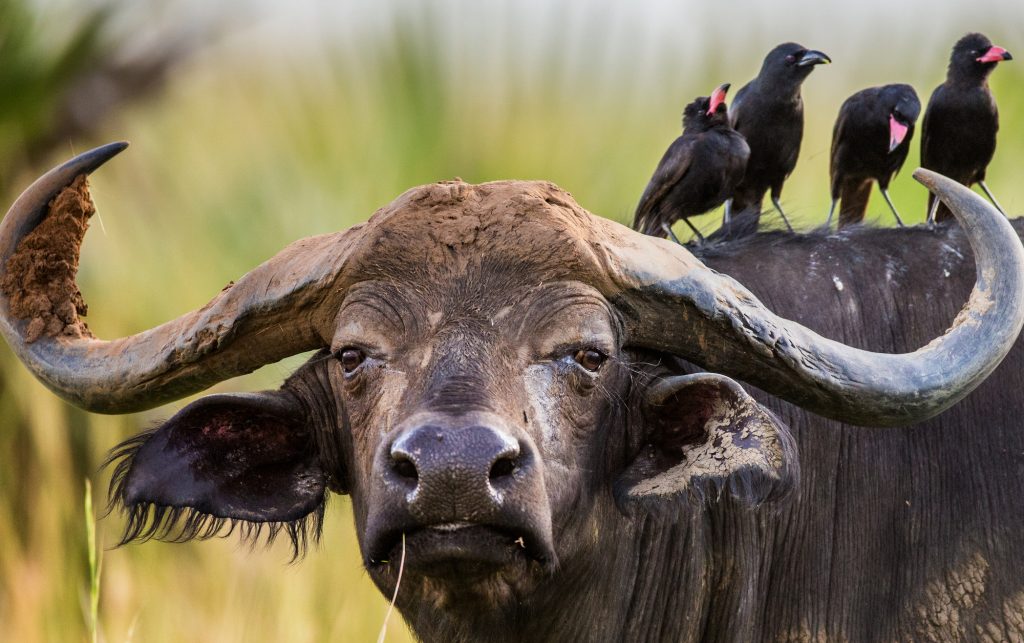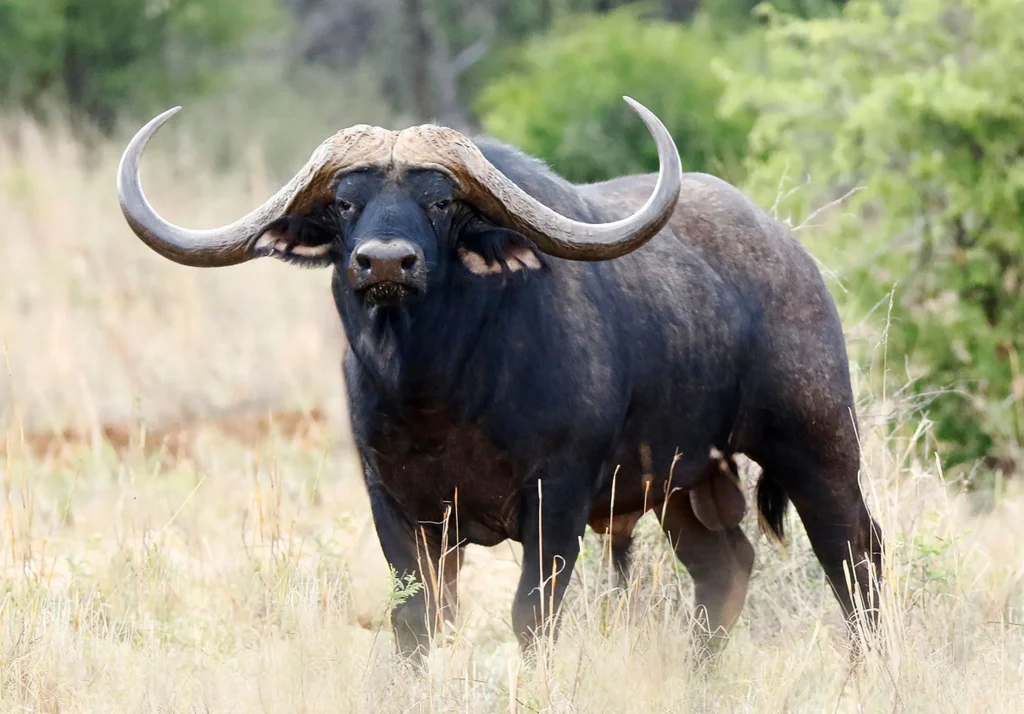African Cape Buffalo Safari – Facts, Habitat, Size & Diet
African Cape Buffalo Safari – Facts, Habitat, Size & Diet
Overview
The African Cape buffalo is one of the animals we prepare you to meet with anticipation. Known as one of the “Big Five,” buffalo are strong, wildest, unpredictable, and always impressive animals you will meet in Africa.
During your game drives, you may see them in huge herds crossing rivers, bulls sparring in open grassland, or solitary old males resting in shade. Each moment during their sighting gives you insight into why these animals are both respected and admired.
Your safari with us positions you in the best places to see buffalo. In East Africa, we take you to open savannas where massive herds graze. In Southern Africa, we guide you along floodplains and wetlands where buffalo gather at waterholes. You’ll learn to recognize the difference between large breeding herds and smaller groups of older bulls, often called “dagga boys.”
A herd of hundreds creates a moving sea of horns and dust and meting a small bachelor group shows strength and stubbornness.
While watching buffalo and lions rustle is one of the most dramatic safari experiences, as lions often target buffalo in coordinated hunts.

African Cape Buffaloes in the Wild
Why You Must See the African Cape Buffalo
Buffalo are part of the Big Five, animals historically considered the most challenging to hunt on foot. Today, they represent one of Africa’s great safari achievements: seeing raw power up close. Their unpredictable nature makes every encounter thrilling.
You must see buffalo to appreciate their resilience. Herds face lions, crocodiles, and droughts, yet they thrive in many ecosystems. They move as a unit, protecting calves in the center and charging threats when needed.
Buffalos are also an incredible photographic subject. A close-up of a weathered bull, mud on his skin and sharp horns curving outward, captures the spirit of the wild. A herd moving at sunset, dust rising, is an iconic safari image.
For guests, buffalo encounter adds balance to your safari. Elephants will show you wisdom, lions show dominance, cheetahs show speed, and buffalo bring sheer strength and unity. They complete your understanding of Africa’s big game.
Finally, seeing buffalo in the wild supports conservation. They play an important role in ecosystems, grazing grasses that stimulate new growth and shaping landscapes for other species.
Recommended Safaris
14-Day Uganda, Congo & Rwanda Gorilla Trekking & Wildlife Safari
$ 4900
per personAfrican Buffalo’s Behaviours
Cape buffalo are social animals, living in herds that range from a few dozen to several hundred individuals. They graze together, move together, and defend each other fiercely. When threatened, the herd often circles calves in the middle, while adults face outward with horns ready.
Males show different behavior depending on age. Younger males stay with herds, while older bulls sometimes live alone or in small bachelor groups. These solitary bulls are more unpredictable and often the most dangerous to approach, which is why guides treat them with respect.
African Cape Buffalo Physical Appearance
Buffalo are heavy-bodied, with dark brown or black coats, large curved horns, and sturdy legs. Usually every herd member looks similar, but older males may have worn coats, scars, and thick horn bases called “bosses.”
Females look slightly smaller and slimmer, though still powerful and aggressively wild. Calves are lighter brown, with softer hair and smaller, less developed horns.
African Cape Buffalo Size
Adult males stand about 1.5 meters at the shoulder and measure up to 3.4 meters in length. Females are slightly shorter and lighter. Calves are small at birth but grow quickly, staying close to their mothers for protection.
African Cape Buffalo Weight
Adult males weigh between 600 and 900 kilograms, while females range from 450 to 700 kilograms while African cape buffalo calves may weigh between 30 and 50 kilograms at birth but increase rapidly as they nurse and graze.
African Cape Buffalo Habitat
Cape buffalo live in savannas, grasslands, woodlands, and swamps. They require water daily, so you always find them within reach of rivers, lakes, or waterholes. Their need for grazing land and water makes their movements predictable during dry seasons.
Buffalo diet consists mainly of grass, though they also browse shrubs when grass is scarce. They graze in the cooler hours of morning and evening, resting in shade or mud during midday.
In dry months, buffalo gather in larger herds at water sources, creating dramatic scenes of hundreds of animals together. In wetter months, they spread more widely across green plains, though they remain in groups for protection.
African Cape Buffalo Gallery
Where To Find It
In Tanzania, the Serengeti and Tarangire host largest herds of buffaloes, while Ngorongoro’s crater floor adds a unique backdrop.
In Kenya, the Masai Mara offers open plains with constant buffalo presence and Uganda’s Queen Elizabeth and Murchison Falls parks have the highest populations, often near rivers.
In Botswana, the Okavango Delta and Chobe floodplains show some of the largest herds in Africa. South Africa’s Kruger National Park also offers consistent sightings year-round.
Top Cape Buffalo Sighting Tips
- Plan drives near rivers and waterholes, since buffalo must drink daily. These areas increase your chances of large herd sightings.
- Choose dry season visits in places like Tarangire or Chobe. Massive herds gather, giving dramatic encounters and photography opportunities.
- Look for old bulls in shaded thickets or near muddy pools. These “dagga boys” are iconic, though guides approach carefully.
- Watch for rustle between buffalo and lions. In Serengeti and Mara, you may see prides attempting hunts, with herds uniting to defend themselves.
- Bring binoculars for distant herds. Spotting lines of buffalo stretching across plains gives you a full sense of their numbers.
- Stay quiet during close encounters because buffaloes sense sound and movement quickly, and calm behavior ensures peaceful viewing.
- For photography, use a mid-range lens for portraits and a wide lens for herds. Dust, light, and horns create striking images.
- Dedicate multiple drives to buffalo sightings. They move widely, and extra time increases your chance of seeing both herds and solitary bulls.
Recommended Safaris
8 Days Murchison Falls, Gorilla, Chimpanzee & Queen Elizabeth Safari
$ 1790
per person14-Day Uganda, Congo & Rwanda Gorilla Trekking & Wildlife Safari
$ 4900
per person3 Days Murchison Falls & White rhino Tracking in Ziwa
$ 620
per personTop Sighting FAQs
Why are buffalo considered dangerous?
Buffaloes are unpredictable. When threatened, they charge suddenly and powerfully. Lone bulls, especially, are known for aggressive behavior. That’s why guides treat them with caution.
From vehicles, however, buffalo usually stay calm if respected. Our experienced guides keep safe distances, so you enjoy the sighting without worry.
How large can buffalo herds get?
Herds may reach hundreds, even up to a thousand in some regions during dry seasons. Watching such numbers cross rivers or move across plains is unforgettable.
During wetter months, herds split into smaller groups to graze, but you still see them daily in buffalo-rich parks.
Do lions hunt buffalo?
Yes. Lions often target buffalo, especially in prides. Hunts are dramatic and risky, as buffalo fight back. Lions may succeed, but sometimes buffalo chase lions away.
Watching this interaction is one of the rawest safari experiences, showing predator-prey balance.
What role do buffalo play in ecosystems?
Buffalo graze heavily on grasses, stimulating new growth and shaping habitats for other animals. They also spread seeds through dung. Their presence influences entire landscapes.
Seeing them in herds gives you a sense of their ecological importance, beyond their power and presence.
Will I see buffalo in water?
Yes. Buffalo often wade into rivers and swamps to drink, cool off, or escape insects. In Chobe, herds crossing rivers create iconic safari scenes.
This behavior adds variety to sightings, from dusty plains to watery crossings.
Do all buffalo have horns?
Yes, both males and females have horns, though males’ are thicker and form prominent bosses at the base. Horns serve for defense and dominance.
Cows use horns mainly for defense, while bulls use them in sparring matches.
How long do buffalo live?
In the wild, buffalo live about 15 to 20 years. Herd protection helps calves grow, but predators and disease shorten lives for some.
Older bulls often live alone, facing greater risks. Seeing a scarred bull is seeing survival written on its body.
Are buffalo related to domestic cattle?
They belong to the same family but are different species. Cape buffalo are wild and cannot be domesticated, unlike cattle.
Their strength and unpredictable behavior keep them firmly in the wild category.
Do buffalo migrate?
They move seasonally in search of grass and water but do not migrate long distances like wildebeest. Movements follow local rainfall and river levels.
This makes them reliable to find in certain parks all year, though numbers shift with seasons.
Where is the best place worldwide to see buffalo?
Chobe in Botswana offers massive herds, Serengeti and Mara provide predator interactions, and Ngorongoro gives dramatic backdrops. Tarangire and Kruger also excel.
We tailor your safari based on whether you want sheer numbers, predator-prey action, or unique scenery
Don’t wait,
book this adventure safari today
Low season
Oct, Nov, Mar, Apr, may
Peak season
Jun, July, Aug, Sept, Dec

Got any questions
about traveling to Uganda?
Get in touch.








